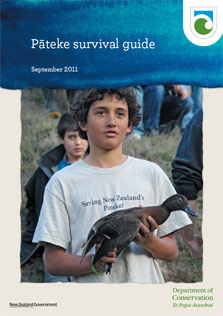Reasons of Decline
A decline in Brown Teal numbers was first noted in the late 1800’s when the species was becoming rare in Canterbury, the Wairarapa and the Manawatu.
Eventually the species became totally protected from hunting in 1921. However, identification of waterfowl game birds was not a priority in those days and Brown Teal continued to be heavily harvested, and for at least the next three decades legal protection meant very little.
The first signs of serious decline also coincided with the wetland drainage and forest clearance that took place on a massive scale in the late 1800’s and the early 1900’s, and which continued largely unabated until the 1970’s.
On top of hunting pressure and habitat destruction, mustelids (Mustelidae) were introduced to New Zealand in 1867 and hedgehogs (Erinaceus europaeus) in 1870. Feral cat (Felis catus) numbers also began to expand and, with land clearance, plus an increasing human population rats (Rattus norvegicus and Rattus rattus) also expanded.
Mustelids – ferrets (Mustela furo) stoats (Mustela erminae) and weasels (Mustela nivalis) were introduced to help keep rabbit and rat populations under control. It is believed by most researchers that New Zealand has suffered far worse than any other country from the impact of predators.
Historically fresh water eels have also impacted on Brown Teal numbers, particularly in respect of duckling survival. Cormorants, particularly the Black Shag (Phalacrocorax carbo), are known, in many areas, to impact on duckling survival – one black shag shot in 1989 was found to have six NZ Scaup (Aythya novaeseelandiae) ducklings in its stomach.
Some success was achieved in controlling rabbit populations, but mustelids soon found that New Zealand’s endemic bird life was far easier to capture and kill. As Thomson stated in 1922 ‘Nothing in connection with the naturalisation of wild animals into New Zealand has caused so much heart-burning and controversy as the introduction of these bloodthirsty creatures’.
Hedgehogs were introduced to keep garden grubs under control, and to make the English feel at home, but they multiplied alarmingly and found the eggs of many ground nesting birds very palatable.
It was also suggested that stock trampling wetlands played a role in the decline. This theory is, however, not supported by Brown Teal behaviour on Great Barrier Island, where teal reside in areas where cattle and sheep graze right down to the waters edge, and where the teal spend most nights feeding in the same paddocks as the farm animals. Although most estuaries supporting Brown Teal on Great Barrier are protected from gazing animals on one side of their roost, usually by high banks and/or fences, and this feature is potentially an important one when it comes to protecting roost sites from farm stock.
A mysterious disease factor has also been suggested by some writers, but no scientific or additional data to support this theory has ever surfaced. But it is strongly suspected that the spread of the introduced Mallard (Anas p. platyrhynchos) has, since the 1050’s, impacted heavily on Brown Teal populations, just as the species has on the NZ Grey duck.
Over the last thirty to forty years the Pukeko (Porphyrio porphyrio) population has multiplied to massive number in many districts, and it is now known that this species has played a major role in reducing the life expectancy of large numbers of Brown Teal ducklings. Pukeko appear to kill a variety of ducklings just for the sake of it!
Earlier it was believed that no single cause was responsible for the decline of Brown Teal, and with rampant mustelids, rats, feral cats, feral and domestic dogs, hedgehogs, pukeko, harrier hawk, eels, shags, weka (Gallirallus australis) on the Chathams Island, massive environmental changes, plus excessive shooting, it is really not surprising that the rodent like and protective Brown Teal population began to disappear, and to retrench to places like Little and Great Barrier Island, the Coromandel, and to other far flung areas of New Zealand, such as, Fiordland and Northland.
Whilst rapid and monumental habitat destruction and changes have taken place on the New Zealand mainland, if we look at the evidence now available we find that on both Great Barrier Island and on Stewart Island, and where Brown Teal habitat has remained relatively unmodified and where there is no waterfowl hunting, no hedgehogs and no mustelids, Brown Teal have still declined; leaving feral cats, harrier hawk and pukeko, a few feral dogs and a few domestic dogs, as the major reasons for the decline.
We should also remember that while Brown Teal are strong fliers they do not take readily to the air and movement between different habitats or roost sights is rare, and they are not readily adaptable to major habitat changes.
Historically there were few Brown Teal on Great Barrier Island and it appears that the expansion of numbers there only occurred during the 1930’s; possibly from birds being pushed out of the Coromandel Peninsula, an area where they were once in large numbers and which is not too far from Great Barrier Island.
Brown teal disappeared from the Chatham Islands in the 1920, but they did hang on much longer on Stewart Island, where the last recorded sighting there was in 1972.
In 2002 Brown Teal were believed to be functionally extinct in the South Island of New Zealand and in 2002 only a few remnant birds which were DNA tested and found to be hybridised with mallards or grey duck.
As already mentioned, the Great Barrier Island predator situation is quite different to that on the mainland – there are no mustelids, hedgehogs. However, there are feral cats, Pukeko, rats and harrier hawks on Great Barrier Island.

